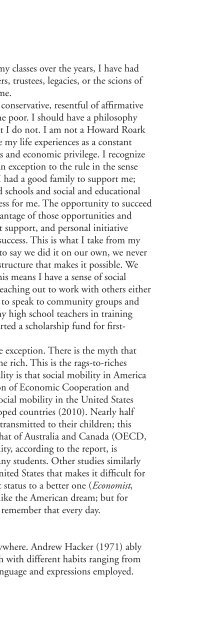WINTER 2012 - National Association of Schools of Public Affairs and ...
WINTER 2012 - National Association of Schools of Public Affairs and ...
WINTER 2012 - National Association of Schools of Public Affairs and ...
You also want an ePaper? Increase the reach of your titles
YUMPU automatically turns print PDFs into web optimized ePapers that Google loves.
Exploring Academic <strong>and</strong> Social Networks<br />
the MPA program. Are students with extensive social networks more successful<br />
in their future career path? If networking is an important part <strong>of</strong> students’<br />
experience with MPA program, we need to further investigate the determinants<br />
<strong>of</strong> scope <strong>and</strong> scale <strong>of</strong> these networks. The answers to these questions hold<br />
practical relevance for MPA program administrators, instructors, <strong>and</strong><br />
participants. All can benefit from recognizing <strong>and</strong> underst<strong>and</strong>ing why network<br />
development is one <strong>of</strong> important motivations for—<strong>and</strong> for some individuals a<br />
paramount aspect <strong>of</strong>—attending a MPA program.<br />
FOOTNOTES<br />
1 This research is supported by the <strong>National</strong> Natural Science Foundation <strong>of</strong> China, Project<br />
Number 71003013.<br />
2 Some network survey instruments were adapted from literature in English. Two authors did<br />
translations independently <strong>and</strong> then compared their versions. To ensure that it was culturally<br />
competent <strong>and</strong> linguistically appropriate for the targeted study subject, the Chinese version was<br />
then critically reviewed by other Chinese researchers <strong>and</strong> pretested by eight Chinese<br />
MPA students.<br />
3 The persons from whom he or she seeks career-related information <strong>and</strong> advice may not be<br />
necessarily the same person with whom he or she shares the information.<br />
4 Closeness centralization measure cannot be calculated for a network with unconnected actors.<br />
REFERENCES<br />
Baruch, Y., Bell, M., & Gray, D. (2005). Generalist <strong>and</strong> specialist graduate business degrees: Tangible<br />
<strong>and</strong> intangible value. Journal <strong>of</strong> Vocational Behavior, 67, 51–68.<br />
Boorman, S. A., & White, H. C. (1976). Social structure from multiple networks. II. Role structure.<br />
American Journal <strong>of</strong> Sociology, 81(6), 1384–1446.<br />
Borgatti, S. P., Everett, M. G., & Freeman, L. C. (2002). UCINET for Windows: S<strong>of</strong>tware for social<br />
network analysis. Harvard, MA: Analytic Technologies.<br />
Burt, R. S., & Ronchi, D. (2007). Teaching executives to see social capital: Results from a field<br />
experiment. Social Science Research, 36, 1156–1183.<br />
Chen, B., & Krauskopf, J. (2010). Integrated or disconnected? Examining formal <strong>and</strong> informal networks<br />
in a merged nonpr<strong>of</strong>it organization. Working Paper Series. Center for Nonpr<strong>of</strong>it Strategies <strong>and</strong><br />
Management, Baruch College <strong>of</strong> the City University <strong>of</strong> New York.<br />
Coleman, J. (1988). Social capital in the creation <strong>of</strong> human capital. American Journal <strong>of</strong> Sociology, 94,<br />
95–120.<br />
Granovetter, M. (1974). Getting a job: A study <strong>of</strong> contacts <strong>and</strong> careers. Cambridge, MA: Harvard<br />
University Press.<br />
Journal <strong>of</strong> <strong>Public</strong> <strong>Affairs</strong> Education 153

















